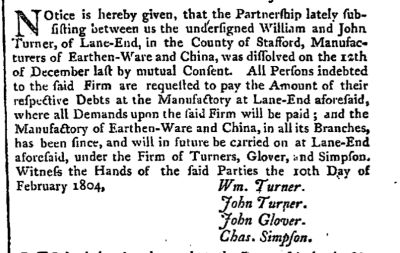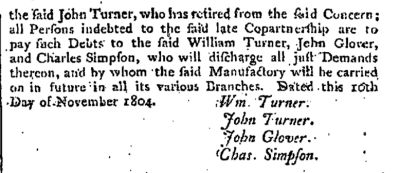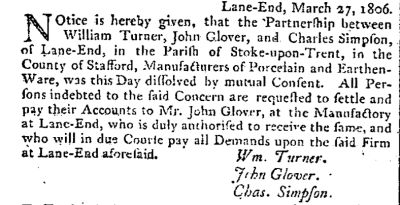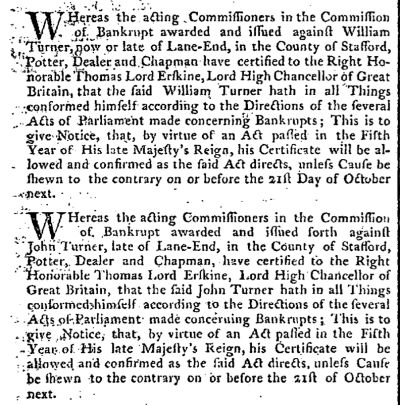![]()
|
John
Turner |
Location and period of operation:
|
John
Turner |
Turner & Banks |
Stoke |
1756 |
1762 |
|
John
Turner |
John
Turner snr's involvement ceased on his death in Dec 1787 |
Lane End |
1762 |
1787 |
|
Turner & Abbot |
London based retail outlet for Turner's ware |
London |
1780 |
1803 |
|
William
& John
Turner |
|
Lane End |
1788 |
Dec 1803 |
|
Turner & Co |
John
& William Turner, Glover &
Simpson |
Lane End |
Dec 1803 |
March |
|
William
Turner |
Following discharge of the bankruptcy requirements William continued on his own until the factory was sold in 1829. |
Lane End |
1806 |
1829 |
| Manufacturer of
Earthenware, Cream-ware, Wedgwood-type ware - Jaspers, etc. at Stoke and
then at Lane End (now Longton), Stoke-on-Trent, England.
Inventors of ironstone-type ware. The Turner family of potters was a prominent English pottery-making dynasty active in the latter half of the 18th and early 19th centuries. The most notable members were John Turner (1737–1787) and his sons William (1762-1835) and John (1766-1824). Based in Lane End, Staffordshire, the Turners were highly regarded for their innovative ceramics, often compared to those of Josiah Wedgwood, with whom they had professional connections. John Turner at Stoke town:
There are no identifiable pieces of
the 1756-62 period but they were likely to be specially made and satirical pieces.
John Turner at Lane End:
Turners and New Hall Porcelain:
The Gerverot Beaker:
Turners' patent:
Bankruptcy & beyond:
Useful
links & publications: Turner
- History of the Staffordshire Potteries, 1829, Shaw Turner
- Printed British Pottery & Porcelain Turner (potters) - Wikipedia - note that there are errors in this Wikipedia article:
|
jump to:
| The Trentham's teapot | The Gerverot Beaker | Turner's Patent Stone | Marks used |
Biography of: John Turner Snr. | William Turner
1804 and after - London Gazette announcements
A Notable Turner Teapot
(manufactured March 1762)
picture and article from the Connoisseur,
May 1907
|
flowers and foliage complete the design - the whole is outlined in a rich dark blue Lord Trentham was four years old at the time of the manufacture of this teapot - the 'dolls' are marionettes
|
"The teapot illustrated appears to be a very interesting, if not unique, specimen of the work of John Turner, of Lane End. It is five inches high and made in a buff-coloured earthenware body, with the surface ornamented with an elaborate design in low relief, of which the prominent feature is the standing figure of a youngish man, dressed in the costume of the middle eighteenth century, and dangling from his right hand one male doll, and from his left two female dolls, all dressed in the style of the same period. Beneath this figure and running round the teapot is the inscription:- LORD TRENTHAM WITH HIS FRENCH DOLLS. Conventional flowers and foliage complete the design. The whole is outlined in a rich dark blue, considerably worn in places. On the base in underglaze lettering is the name and date,
"M. Degg, There are several remarkable points about this
teapot. To begin with, it must have been one of the very first pieces of pottery made by John Turner Again, it is so
unlike Turner’s usual style that it naturally occurs to Connoisseur, May 1907 p.51 |
The Gerverot Beaker
(manufactured July 1787)
|
"After Mr. Turner had separated from the New Hall Company, he commenced the manufacture of porcelain, at Lane End; and one of the ornaments he made, is now preserved by Broadhurst Harding, with truly laudable care and anxiety.
[now in the British Museum]
|
|
See: The Turners of Lane End - Hillier Chapter Six. |
 Duvivier
|
Turner's Patent Stone
On
19th January 1800 William Turner was awarded patent number 2367
for
the manufacture of what was known as Patent Stone
- see details of ironstone-type development -
|
"In 1800, Mr. W. Turner having amused himself with examining by chemical analysis the different strata perforated in sinking a new shaft of a Coal Pit at Milfield Gate, discovered, in what is called the Taberner's (or Little) Mine, a mineral, which by calcination becomes a pearl white, yet unlike other minerals, does not shrink by the most ardent temperature to which it has been subjected — 130° of Wedgwood's pyrometer. This is now called Patent Stone, in consequence of the brothers Turner having obtained Letters Patent for manufacturing, with it as one material, a real Porcelain, wholly different from any previously manufactured. The stone is very different from the Iron Stone; and therefore the present Patent Ironstone China must not be confounded with the other Patent Porcelains, Champion's and Turners'. The late J. Spode, Esq. purchased the right to manufacture this patent Stone Porcelain; and a fine specimen of it has already been noticed." 'History of the Staffordshire Potteries', published in 1829 by Simeon Shaw. p. 172
|
 |
 Turner's Patent N8 is probably a pattern number |
photos courtesy: Robert Fountain

A Turner's Patent ironstone
part-dessert service with Turner's-Patent marks
Waterlily pattern c. 1800-5
photo source: Christie's
 Jasper teapot - Turner & Co
|
 Turner & Co
|
photo source: Appleby Antiques
 House on the Bridge - William Turner Collection of Potteries Museum & Art Gallery, Stoke-on-Trent photos
and text source: Printed
British Pottery & Porcelain |
 TURNER Mist Sole Agent "Small rectangular dish or stand, Turner's patent ironstone china with underglaze blue printed decoration. The design is known as House on the Bridge and depicts an exotic scene with a house at the extreme right of a three-arched bridge. It is impressed on the reverse TURNER MIST SOLE AGENT indicating that this was made by Turner for retail by James Mist of London. Mist was in various partnerships until he was sole owner of the company between 1811-1818. The piece must have been produced for Mist during those years and consequently it must have been made by William Turner who had started up in business in 1806 after the partnership with his brother ceased on their bankruptcy that year. The pattern is also known in a version produced by Charles Heathcote & Co. who had a factory near to Turner and appears to have acquired a number of his copper plates." |
|
Marks used on ware for identification: 'As a general rule the mark used throughout the life of the firm was simply the impressed name "TURNER", although "TURNER & CO" was used between 1803 and 1806. Several marks after 1784 include the Prince of Wales' Feathers, reflecting the firms appointment as potters to the Prince'. Coysh & Henrywood
NOTE:
Jasper ware which carries the impressed mark "TURNER JASPER
WARE" was not made by Turner. |
TURNER
impressed
mark
c. 1770+
I TURNER
Godden
notes this as a rare impressed mark
c. 1770-87
TURNER & CO
impressed
mark
c. 1803-6
The Turner
brothers partnership was enlarged to include John Glover and Charles
Simpson.
Turner & Co ceased trading in Dec 1804 and the partnership was
dissolved March 1806.
Godden notes that '& Co' was also "probably used c. 1780-6"
TURNER'S PATENT
painted mark on stone-ware
|
impressed mark c. 1770+ |
printed or impressed mark include the Prince of Wales' Feathers 1784+ |
hand painted mark January 1800 Turner's were a patent
|
impressed mark (example
show is on Jasper ware) |
made by William Turner for retail by James Mist of London. Mist was in various partnerships until he was sole owner of the company between 1811-1818. |
Biography of: John Turner Snr.
|
TURNER, John (1737-87), pottery manufacturer, Lane End (now called Longton) John Turner of Lane End was christened 7th Jun 1737 at St Nicholas Church, Newport, Shropshire to parents Walter Turner & Mary Phipps. Where he attended school is not known but he was sufficiently well-educated to be able to write his pottery chemical formulae in French to guard against industrial espionage. He was apprenticed to a Staffordshire potter, Daniel Bird, in 1753, and was established by 1756 in a partnership with R. Banks, making white stoneware, in a factory on the site of what became Copeland-Spode, in Stoke upon Trent. He moved to Lane End in 1762. (Jewitt). He was acknowledged as being 'one of the cleverest and most successful potters Staffordshire ever produced.' The earliest dated piece attributed to him is a 1762 teapot. About 1780 he discovered a vein of fine clay, peacock marl, at Green Dock, Edensor (Longton), from which he made a wide variety of ware of a cane colour. He also produced a blue glazed pottery similar to Japanese porcelain. He was both a friend and commercial rival of Josiah Wedgwood. John Turner was one of the six founders of the New Hall Works, Shelton. John Turner was a pioneer of the atmospheric Newcomen steam engine in the Potteries, installing one in his pottery in 1775. He was appointed potter to the Prince of Wales in 1784 and some of the ware is marked with the Prince of Wales feathers. He married Ann nee Emery on 15 October 1759 and by her had three sons and three daughters. His sons William and John later became his partners, continuing the business after his death on 24 December 1787. The firm was declared bankrupt in 1806. William continued on his own until 1829 when the factory was sold.
|
Biography of: William Turner
|
TURNER, William (1762-1835), pottery manufacturer, Longton. William Turner was born in 1762, the son of John Turner. With his brother John he was in partnership with his father in the works at Lane End (Longton). After John Turner senior's death William and his brother John jnr. continued the business. On 19 January 1800 they took out a patent for the manufacture of a new kind of stoneware called Turner's patent, which used Tabberner's mine rock. The rights were sold to Spode in 1805. The firm was declared bankrupt in 1806 and William continued on his own until the factory was sold in 1829. The firm's productions were among the best wares of their day, equaling Wedgwood's in quality and sometimes being mistaken for them. William was in Paris during the French Revolution, was arrested and escaped with his life only by the intervention of the British ambassador, the marquis of Stafford (later Duke of Sutherland). The effects of the revolutionary and Napoleonic wars contributed to the firm's financial collapse in 1806. William, a rather more public figure than his brother John, was a major in the Longton volunteers in 1803. His bust, by George Ray, is in Stoke on Trent City Museum. William Turner died in Longton on 5 July 1835.
|
|
1804 and after - Turner & Co:
|
| The
London Gazette 14th February 1804  notice of the dissolution of the partnership between William & John Turner - John Glover and Charles Simpson joined them and the business became Turner, Glover & Simpson |
The
London Gazette 17th November 1804   notice that John Turner retired from the business |
The
London Gazette 1st April 1806  notice of the dissolution of the partnership between William Turner, John Glover and Charles Simpson |
The London Gazette
27th September 1806

notice that William and John
Turner had conformed
to the bankruptcy requirements placed upon them
Questions, comments, contributions? email: Steve Birks